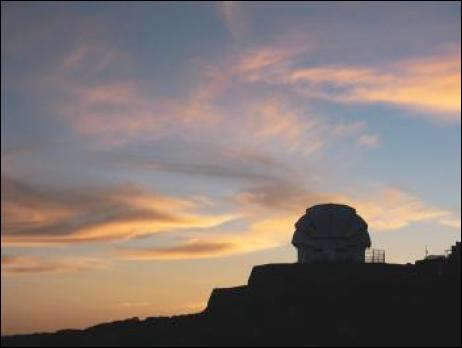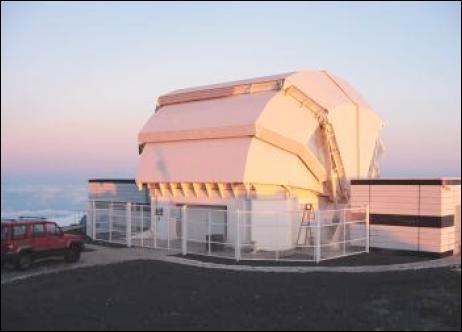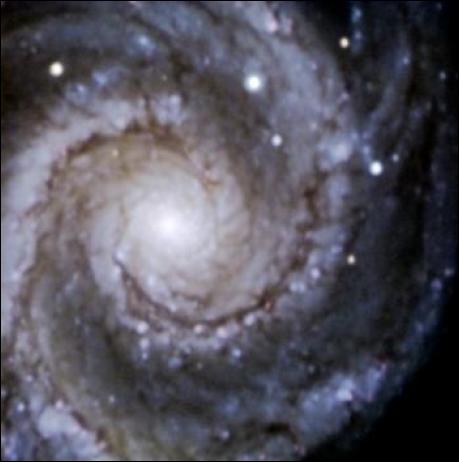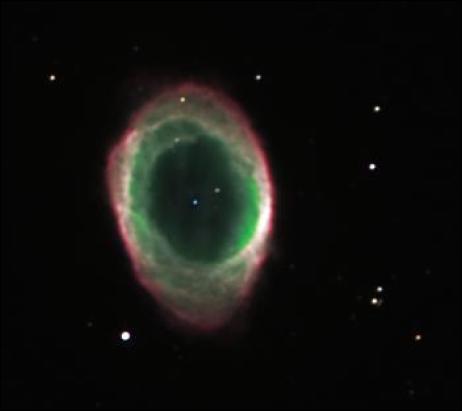World's largest robotic telescope ready for action
World's largest robotic telescope ready for
action
"First Light" on the Liverpool
Telescope
The Liverpool Telescope, the world's largest fully robotic telescope, has snapped its first images of the heavens this week. This 2 meter optical telescope is owned by the Astrophysics Research Institute (ARI) of Liverpool John Moores University (JMU), but observes autonomously from its site on La Palma in the Canary Islands. The telescope was designed, constructed and commissioned by Telescope Technologies Ltd., a subsidiary company of JMU.

Telescope External Views These photographs show the distinctive and novel enclosure of the Liverpool Telescope, quite different from the domes familiar from most telescopes. At night the entire enclosure opens like a clam-shell, to reveal the telescope.

The Liverpool Telescope's unique capabilities of flexible scheduling and rapid response will put the UK at the forefront of exciting new fields of research in time domain astrophysics. "This enables us to study such phenomena as supernovae and Gamma Ray Bursts - the biggest explosions in space," said Prof. David Carter of the ARI. The telescope's other great strength is its ability to make regular observations of objects that vary over periods from seconds to years. This is very difficult with current astronomical facilities. It can also track newly discovered objects such as comets or near-Earth asteroids, allowing accurate calculations of their paths and potential hazard.
The telescope is supported by the Particle Physics and Astronomy Research Council, making 40% of the observing time available to astronomers throughout the UK. A further 5% of the time has been donated by JMU to the National Schools' Observatory (NSO) programme. "School children can now work on their own projects alongside professional astronomers," said Dr. Andy Newsam (NSO astronomer). This is the first time regular access has been granted to schools on world-class research telescopes.

A Globular Cluster (M13) A dense ball of stars that orbits our galaxy at a distance of 25,000 light years. Hotter stars show blue in this image. Cooler stars are yellowish.

The Whirlpool Galaxy (M51)
A large spiral galaxy somewhat like our own Milky Way
but located about 30 million light years away.

The Ring Nebula (M57)
A "planetary nebula" - the glowing shroud surrounding the
remains of a dead star. The white dwarf stellar remnant can
be seen in the centre.

The Dumbbell Nebula (M76)
A "planetary nebula" - the glowing shroud of gas
surrounding the remains of a dead star. The dramatic colours
tell us about the chemical composition of the gas.
Notes for Editors
The Astrophysics Research Institute (ARI) is the astrophysics research and teaching department of Liverpool John Moores University (JMU). It operates the Liverpool Telescope on behalf of the university and the research community.
Telescope Technologies Limited is a wholly owned subsidiary of Liverpool John Moores University focussed on the design and production of high specification equipment including large astronomical telescopes and instrumentation.
The telescope is sited at the Observatorio del Roque de los Muchachos which is operated on the island of La Palma by the Instituto de Astrofisica de Canarias.
The Particle Physics and Astronomy Research Council (PPARC) is the UK's strategic science investment agency. It funds research, education and public understanding in four broad areas of science - particle physics, astronomy, cosmology and space science.


 University of Auckland: Protecting Young Minds With AI
University of Auckland: Protecting Young Minds With AI Greenpeace: Greenpeace Calls On Fonterra Investors To Consider Big Picture With Giant Puzzle
Greenpeace: Greenpeace Calls On Fonterra Investors To Consider Big Picture With Giant Puzzle Hugh Grant: How New Tech Helps Kids Love Soccer More
Hugh Grant: How New Tech Helps Kids Love Soccer More Bill Bennett: Download Weekly - 100% claim lands One New Zealand in criminal court action
Bill Bennett: Download Weekly - 100% claim lands One New Zealand in criminal court action FSCL: Woman Scammed Out Of $25,000 After Job Offer On LinkedIn
FSCL: Woman Scammed Out Of $25,000 After Job Offer On LinkedIn NIWA: Cheers To Crustaceans - New Species Named After Welly Brewery
NIWA: Cheers To Crustaceans - New Species Named After Welly Brewery



